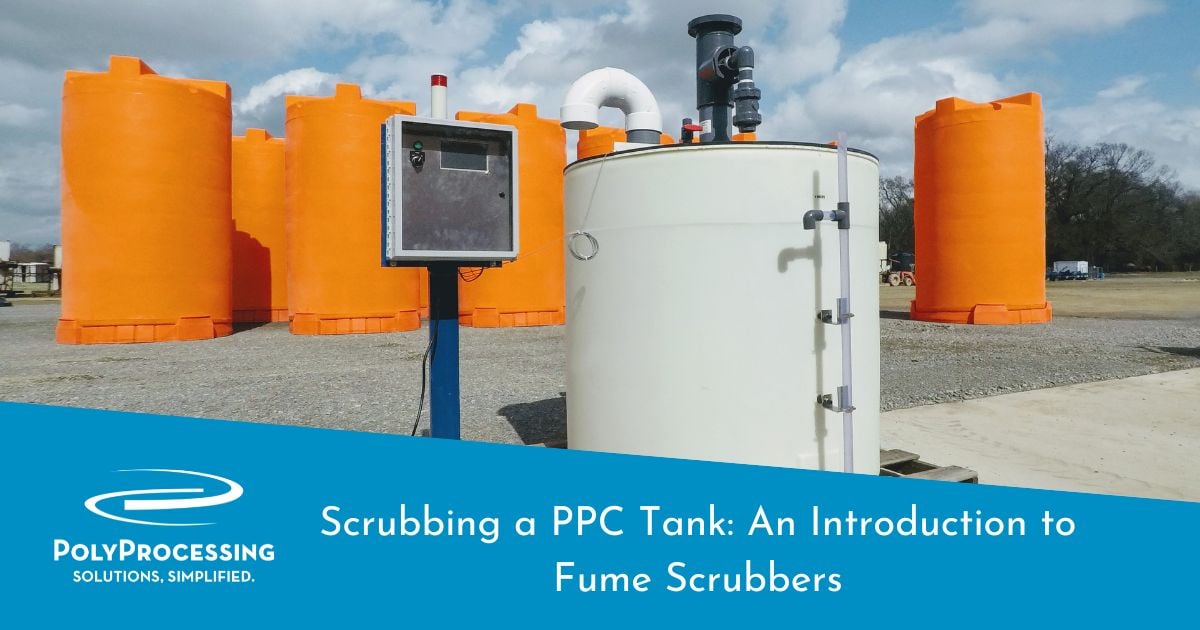Scrubbing a PPC Tank: An Introduction to Fume Scrubbers
Chemicals stored in polyethylene tanks require venting. Depending on the chemical you’re storing, the harmful fumes emitted from the storage tank can’t be directly released into the atmosphere. To reduce the harmful fumes before they evacuate the system and to control air pollution, fume scrubbers need to be installed.

Which fume scrubber systems do you need, and how do you use them? This article will help bring some clarity to these questions. You can also learn about chemical fume scrubbers in the Poly Processing Chemical Storage Tank System and Accessories Product and Resource Guide.
The PolyScrub™ Wet Scrubber
Poly Processing Company (PPC) offers a polyethylene chemical storage tank scrubber solution called PolyScrub. PolyScrub is an ideal solution for facilities in search of a cost-effective chemical fume scrubber.
The scrubber is engineered to process vapor that is discharged from chemical tanks during operation and filling. Each PolyScrub is designed by our application engineers to accommodate proper ACFM (Actual Cubic Feet Per Minute) for your specific system.
How The PolyScrub™ Wet Scrubber Works

The PolyScrub functions by contacting the target compounds with a scrubbing solution. Often, the solution is simply water, but it can also be a particular reagent to address specific chemicals.
Some of the chemicals that are stored in Poly Processing Company tanks that require scrubbers are hydrochloric acid, ammonia, and acetic acid.
When storing these types of chemicals, it's important to construct a system that addresses venting needs by installing a compatible scrubber.
As with typical wet scrubbers, the PolyScrub system introduces water or a specific scrubbing solution through a submerged plenum. The fumes percolate up and through the scrubbing solution, then vent out of the top of the scrubber system.
Custom Designing and Building Your Wet Scrubber
Let's take a look at how the PolyScrub fume scrubber is built for your chemical storage tank application. We start with a crosslinked polyethylene open-top tank. We then manufacture an Ultra High Molecular Weight lid with the necessary size fitting package for your specific application.
Once the lid is constructed, we build a plenum (also known as a diffuser), which goes inside the tank. This plenum is used to distribute the fumes from the bulk tank into the liquid media of the wet scrubber.
When fitting a PolyScrub™ system, normally a 6" vent pipe is installed in the bulk tank. The pipe elbows over and down and connects to a flange attached to the top of the scrubber. This allows the bulk storage tank to vent into the scrubber and not into the atmosphere.
Scrubbers are typically sized for the particular bulk storage tank being used and the specific chemical that needs to be scrubbed.
PolyScrub™ is available in a passive model, which is monitored and pH-adjusted by an operator.
Basic Rules for Scrubber Design/Build
Poly Processing recommends purchasing one of our scrubbers for use with a PPC tank. We have years of experience building scrubbers for our tanks and we know what designs work safely and effectively.
PPC does not build scrubbers for other manufacturers’ tanks.
Some of our customers want to build their own chemical scrubbers, but these scrubbers and scrubber designs don’t meet the safety guidelines of a professionally designed and built PPC scrubber. The safety and longevity of a tank system rely on a properly designed and built bulk tank as well as a properly designed and built scrubber. It is the entire system that delivers peace of mind that you have the right products for your specific application.
A few of the basic safety rules for scrubber design include:
- PPC scrubber systems have a built-in overflow so that the submersion depth of the plenum cannot exceed 10 inches water column which is the absolute maximum pressure for polyethylene tanks. The submersion depth of the plenum is set to operate between 6 and 8 inches water column in order to maintain a margin of safety.
- The plenum should be a slotted pipe with .010” slots and the slots should be every .125”. The slotted openings in the plenum must exceed the cross-sectional area of the connecting vent pipe by 120% for a margin of safety. See PPC PolyScrub Basic Drawing.
- The liquid media in the scrubber should be 1.1 spg or less. Specific gravity affects the back pressure of the scrubber system.
There is a great deal of discussion about how the bulk tank is filled. Whether it is pneumatically filled or mechanically filled, the issue is the air purge in the line. Some mechanical pumps will send an air purge through the line at the end of the pumping cycle. This can create an over-pressurization situation of the bulk tank, unless the venting in the system is intelligently designed.
The bulk tank vent and vent connection to the scrubber should be sized according to the PPC venting matrix.
For more information about wet scrubbers for your polyethylene storage tank, contact one of our tank engineers.
- December 25, 2023
- Topics: Fittings and Accessories
About Poly Processing
Posts By Topic
Tech Talk Podcast Episodes
Subscribe By Email
Recent Posts
- Installation Tips for Chemical Storage Tanks: Site Preparation and Offloading
- Understanding pH and Chemical Concentration When Choosing a Chemical Tank
- Maximizing Fill Efficiency: Selecting the Optimal Fill Line System
- Chemical Storage Tanks: A Quick Guide for End Users
- Popular Customization Options for Chemical Storage Tanks
Tank Configurator

Find the recommended tank and system components for your chemical storage challenge.
Configure a Tank Package






